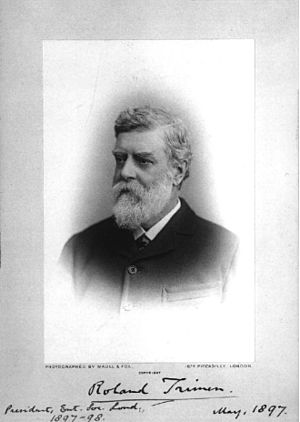Roland Trimen facts for kids
Quick facts for kids
Roland Trimen
|
|
|---|---|

In 1897
|
|
| Born | 29 October 1840 |
| Died | 25 July 1916 (aged 75) London
|
| Education | King's College School |
| Known for | South African Butterflies |
| Spouse(s) | Henrietta Bull |
| Awards | Darwin Medal |
| Scientific career | |
| Fields | Entomology |
| Institutions | South African Museum |
Roland Trimen (born October 29, 1840, in London – died July 25, 1916, in London) was a British-South African naturalist. A naturalist is someone who studies nature, including plants and animals. Trimen was especially famous for his work on butterflies.
He is best known for his book South African Butterflies, which he wrote with Colonel James Henry Bowker. Trimen was one of the first entomologists (scientists who study insects) to look closely at how butterflies use mimicry and polymorphism. Mimicry is when one animal looks like another to protect itself. Polymorphism means an animal can have different forms or colors within the same species. He also worked with the famous scientist Charles Darwin to study how Disa orchids are pollinated. Pollination is how plants reproduce, often with the help of insects.
Contents
Roland Trimen's Early Life and Career
Roland Trimen was born in London in 1840. His younger brother, Henry Trimen, also became a famous botanist, studying plants in Sri Lanka. Roland went to school at King's College School in Wimbledon.
From a young age, Trimen was very interested in insects, especially butterflies. He had a health problem with his throat, so he moved to the Cape of Good Hope in South Africa. The warmer climate was thought to help him feel better.
Working at the South African Museum
Once in South Africa, Trimen volunteered at the South African Museum. He helped organize their collection of beetles. This was a great way for him to learn more about insects.
In 1860, he started working for the Cape Public Service as a clerk. He later became a private secretary for important people, including Sir Henry Barkly, who also loved plants. From 1866 to 1867, Trimen worked part-time as a curator at the South African Museum. A curator is someone who takes care of a museum's collections.
In 1873, he became the part-time curator of the South African Museum again. He could only work there one day a week because he was still the governor's private secretary. In 1876, he became the full-time curator. He stayed in this important role until 1895. He had to leave because of his health.
Trimen's Work on Butterflies
Roland Trimen spent many years studying butterflies in the Cape region of South Africa. He published several articles in science journals during this time.
Important Books and Papers
In 1862, he published the first part of his big work called Rhopalocera Africae Australis. This book was the first time anyone tried to describe all the known butterflies in South Africa. It included details about their larvae (caterpillars), pupae, where they lived, their habits, and when they appeared.
Over the next 30 years, Trimen wrote many important papers about butterflies, including:
- "On the butterflies of Madagascar" (1864)
- "Notes on the butterflies of Mauritius" (1867)
His most famous work on butterflies was a three-volume series called South African Butterflies: A Monograph of the Extra-Tropical Species. He wrote this with James Henry Bowker between 1887 and 1889. This huge work described 380 different species of butterflies! Because of his many publications, Trimen became the top expert on South African butterflies during his time.
Trimen received butterfly specimens from many friends, including Bowker and his sister Mary Elizabeth Barber. His amazing collection of butterflies was later bought by James John Joicey.
Other Scientific Interests
Trimen was also interested in other areas of science. He was part of the Vine Diseases Commission in 1880. This group studied diseases that affected grapevines. He even went to an international meeting in France in 1881 to talk about a plant disease called Phylloxera.
He also described a new type of bird, the racket-tailed roller. He did this by studying bird skins at the South African Museum. Trimen also studied how orchids are pollinated. His work on orchids was so interesting that it led to him exchanging letters with Charles Darwin!
Besides butterflies, birds, and orchids, Trimen wrote about other animals too. He wrote papers about leopards, sun-birds, the teeth of a whale, and rare fish.
Awards and Memberships
Roland Trimen received many honors and was part of several important scientific groups:
- He became a member of the Entomological Society of London in 1859 and was its president from 1897 to 1898.
- He became a Fellow of the Linnean Society in 1871.
- He was made a Fellow of the Royal Society of London in 1882. This is a very high honor for scientists.
- He was a founding member of the South African Philosophical Society and its first secretary. He later became its president.
- The University of Oxford gave him an honorary Master of Arts (MA) degree in 1899.
- He received the Darwin Medal from the Royal Society in 1910. This medal is given to scientists who have made important contributions to biology.
Private Life
Roland Trimen married Henrietta B. Bull in 1885. They did not have any children.
See also
- Butterfly genus Deloneura
- Butterfly genus Durbania
- The Brenton blue butterfly
- Butterfly species Libythea laius
- Butterfly genus Erikssonia
Images for kids


